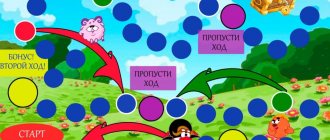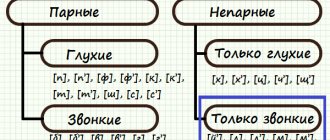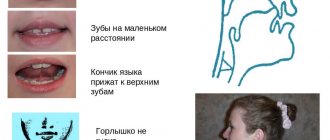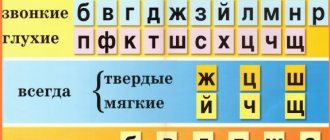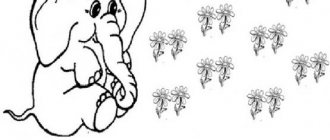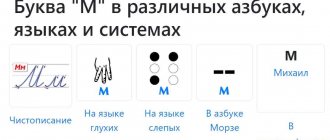Corrective work for violations of sound pronunciation (s-f)
Methodological development: Corrective work in case of violation of sound pronunciation (replacing the sound S with F).
Dyslalia is a violation of sound pronunciation with normal hearing and intact innervation of the speech apparatus.
There are two main forms of dyslalia depending on the location of the disorder and the reasons causing the defect in sound pronunciation - functional and mechanical (organic).
In cases where no organic disorders are observed, they speak of functional dyslalia. When there are deviations in the structure of the peripheral speech apparatus, they speak of mechanical dyslalia.
Functional dyslalia includes defects in the reproduction of speech sounds (phonemes) in the absence of organic disorders in the structure of the articulatory apparatus. With this defect, there are no organic disorders of the central nervous system that impede movement. The specific speech skills to voluntarily assume the positions of the articulatory organs necessary for pronouncing sounds are unformed. This may be due to the fact that the child has not developed acoustic or articulatory patterns of individual sounds.
In functional dyslalia, there are three main forms of dyslalia:
- Acoustic-phonemic (sensory) dyslalia - replacement and mixing of sounds that are more complex in articulation.
- Articulatory-phonetic (motor) dyslalia is a distortion of sounds.
- Articulatory-phonemic (mixed) dyslalia - this form includes defects caused by the immaturity of the operations of selecting phonemes according to their articulatory parameters in the motor part of speech production.
The mechanism for this defect can be both insufficient strength and mobility of the organs of the articulatory apparatus, and an insufficient level of differentiation of phonemic hearing.
Etiology of the disorder: biological (frequent somatic diseases of the child), social (deficiency of speaking and perceived speech, incorrect speech environment).
Symptoms of the disorder: replacement and mixing with lighter sounds in articulation.
There are two main types of violations.
- In the first case, the articulatory base is not fully formed; when choosing phonemes, instead of the desired sound (which is absent in the child), a sound that is close to it in terms of a set of articulatory features is selected. A sound of simpler articulation acts as a substitute.
- In the second variant of the disorder, the articulatory base is fully formed, all articulatory positions necessary for the production of sounds have been mastered, but when selecting sounds, an incorrect decision is made, as a result of which the sound appearance of the word becomes unstable (the child can pronounce words correctly or incorrectly).
Substitutions and mixtures in the mixed form of dyslalia are carried out on the basis of the articulatory proximity of sounds. But these phenomena are observed primarily between sounds or classes of sounds that differ in one of the following characteristics:
- whistling and hissing (s-sh, z-zh),
- explosive noisy front-lingual and back-lingual (t-k, d-g),
- paired in articulation lingual hard and soft phonemes (s-s, l-l, t-t),
- affricates (ts-h),
- sonors (r-l).
Defective pronunciation in this form of dyslalia is caused not by motor impairments themselves, but by a violation of the operations of selecting phonemes based on their articulatory characteristics.
Correct articulation of sound [C]:
- Lips: not tense, stretched, as with a slight smile;
- Teeth: 1-2 mm closer together, upper and lower incisors exposed;
- Language:
- the tip is wide, lies at the base of the lower incisors, without touching their apices,
- the front part of the back is wide, rises to the alveoli and in the middle forms a groove-shaped gap with it,
- the middle part of the back is lowered, a longitudinal groove is formed in the middle of it,
- the back of the backrest is slightly raised,
- the lateral edges are adjacent to the inside of the upper molars, closing the passage of the air stream;
- Soft palate: raised and pressed against the back wall of the pharynx, closing the passage of air into the nasal cavity;
- Vocal folds: not tense, spread apart, no voice is formed;
- Air stream: narrow, cold, runs along the midline of the tongue, felt by the back of the hand;
Failure of sound articulation [S], labial-dental parasigmatism (F):
If the sound [S] is not pronounced correctly, a noise similar to a whistle is formed, the sound [S] is replaced by the sound (F)
- Lips: the lower lip is close to the upper incisors;
- Teeth: lower teeth not visible, upper teeth slightly exposed;
- Language:
- the tip of the tongue is pulled away from the lower incisors,
- the front part of the back of the tongue is lowered and slightly pushed back,
- the middle part of the back is raised and slightly moved back,
- the back of the backrest is raised,
- the lateral edges of the tongue are adjacent to the upper molars;
- The soft palate is raised and pressed against the back wall of the pharynx, blocking the passage of air into the nasal cavity;
- The vocal folds are not tense, they are spread apart, the voice is not formed;
- The air stream is more diffuse, passing between the lower lip and upper incisors.
- Predisposing factor: prognathism, impaired phonemic hearing.
Thus, work to correct this sound consists of the following steps:
Stage 1 – preparatory
Formation of correct articulation, exercises for practicing the movements of the lower lip up and down, developing the position of the lips in a smile with the exposure of the upper and lower incisors, the ability to flatten the tongue, hold the tip of the tongue behind the lower incisors, a long air stream in the middle of the tongue. Forming the ability to distinguish sounds S-F by ear, practicing the sound I, the combination IE.
Phonemic hearing correction:
- Differentiation of non-speech sounds.
- Differentiation of hearing by longitude, strength and height, timbre.
- Differentiation of words: - words of the same length and different in content,
- - words of quasi-homonyms.
- Differentiation of syllables.
- Phoneme differentiation.
- Phonemic analysis and synthesis.
Articulation gymnastics:
1. "Spatula"
Smile, open your mouth. Place your wide tongue on your lower lip. Hold calm for a count of five. In this exercise, it is important to ensure that the lower lip does not tense or pull on the lower teeth.
Place your tongue with a spatula and keep it counting: One, two, three, four, five! The tongue needs to be relaxed!
2. "Proboscis"
Lips and teeth are closed. Pull your lips forward with tension. Hold them in this position for a count of five.
I imitate an elephant. I pull my lips with my proboscis. And now I let them go and return them to their place.
3. "Pussy is angry"
Smile, open your mouth. Place the tip of your tongue against your lower teeth. On the count of “one”, bend your tongue out into a slide, resting the tip on your lower teeth. On the count of two, return to the starting position. The tip of the tongue should not come off the lower teeth, and the mouth should not close.
On the bench by the window the cat lay down and dozed. The cat opens its eyes, the cat arches its back.
4. “Stubborn Donkey”
Lips in a smile, mouth slightly open. Pronounce the sound combination IE with force. The tip of the tongue rests against the lower teeth.
5. "Swing"
Smile, open your mouth. On the count of “one-two”, alternately rest your tongue on the upper and lower teeth. The lower jaw is motionless.
On the swing I swing up and down, up and down. I rise higher and higher, and then down.
6. “Count the bottom teeth”
Smile, open your mouth slightly. The tip of the tongue rests in turn on each lower tooth from the inside. Make sure that the lower jaw is motionless.
Something happened to the tongue, it pushes its teeth! As if he wants to push them out by the lips for something.
At the automation stage, sound is introduced into forward, backward, and confluent syllables, into words and phrasal speech. Sometimes automation in syllables begins using mechanical assistance.
Sound automation:
- In syllables:
- straight - sa, so, su
- reverse - ac, os, us
- with a combination of consonants - hundred, spa, sma (ast, asp)
- In words:
- (sound at the beginning of a word) – himself, sleigh, bag
- (conjunction of consonants) – knock, bench, satellite
- (sound in the middle of a word) – wasp, braid, sock
- (sound at the end of a word) – pineapple, coconut, belt
- (words with two sounds) – nipple, sauce, pump
— In phrases
– delicious soup, mother’s beads, a well-fed dog.
- in sentences:
3 words – Catfish have mustaches. The son is eating soup. The son is washing the dishes. 4 words – Sonya eats the soup herself. The dog eats a piece of meat. 5 words – The dog Jay is standing under the pine tree. Sonya has a waist-length braid.
— in verses and pure sayings:
Pussy, pussy, where's your bowl? A pussy eats soup from a bowl: If the pussy is full, the bowl is empty.
Snow is falling, falling from the sky. The winter forest sleeps under the snow. The sleepy garden is covered in snow. The garden is also sleeping under the snow.
The gray goose takes care of her son. The gosling is sleeping in a sweet dream under the goose's wing.
- story, retelling:
Scooter
Sanya has a scooter. Sanya thinks: “I’ll stand on the scooter, the scooter will take me for a ride. That’s why he’s a scooter!” Sanya stepped on the scooter, but the scooter didn’t move or roll Sanya anywhere. Denis rides past Sanya on a scooter. “Yeah, so we have to go!” - Sanya thinks. And Sanya rushed off on his scooter to the shady garden.
- in tongue twisters:
Sanya's sleigh moves on its own. Sysoy has a waist-length mustache.
Differentiation of sounds [S] - [F].
In syllables: Sa-fa, so-fo, su-fu, sy-fy. As-af, os-of, us-uf, ys-yf Sa-sa-fa, sa-fa-sa, fa-sa-sa
In words: son-fon, canopy, whistle.
In phrases: delicious sour cream, bus stop, high wall.
In sentences: The bus is moving. There are a lot of wasps in the garden. Anfisa buys beads for herself. We have bushes and tall pine trees in our garden.
In verses and pure sayings:
In the garden are Stas's and Vanya's sleighs. Stas takes us for a ride on a sleigh.
As-as-as - we have kvass at home, Os-os-os - there are a lot of wasps in the garden, Us-us-us - Sanya has a new bus, Ys-ys-ys - Denis drinks kumiss.
In the texts (story, retelling):
In the garden.
This is a shady garden. There are pine trees and bushes in the garden. Denis and Stas ride through the garden on scooters. This is the tallest pine tree. There is an owl and two owlets on a pine branch.
In tongue twisters:
Stas takes Pastila and sweet kvass out of his bag. Stas will treat you and me to sweet kvass with marshmallows.
Semyon and Savely blew whistles.
The owl advises the owl: “Sleep, neighbor, on the sofa.” It’s so sweet to sleep on the sofa, to soak up the sleep of owls.
Bibliography:
- Volkova L. S., Shakhovskaya S. N. Speech therapy, third edition. – M., 2003
- Lalaeva R.I., Paramonova L.G., Shakhovskaya S.N. Speech therapy in tables and diagrams. – M., 2015
- Krause E. N. Speech therapy massage and articulation gymnastics. Practical guide. – St. Petersburg, 2004
- Spivak E. N. Sounds S, S', Z, Z', Ts. speech material for automation and differentiation of sounds in children 5-7 years old.
| Bondarenko N.N., speech therapist teacher |
- Rehabilitation training program for swallowing disorders
- Examination of the sound pronunciation of children with erased dysarthria
- Formation of the skill of correct pronunciation of whistling sounds
- Individual correction program for senior group students for 1 period of the school year
- Games aimed at developing correct sound pronunciation
( 3 liked, average score: 5.00 out of 5)
Loading...
